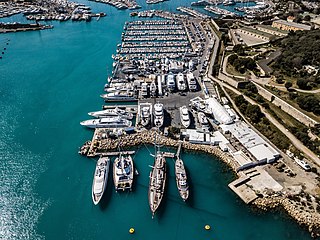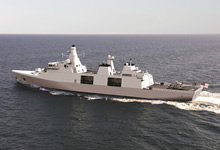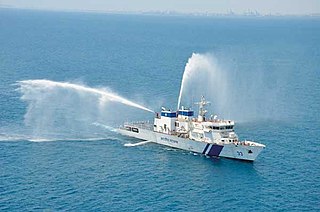Related Research Articles

A shipyard is a place where ships are built and repaired. These can be yachts, military vessels, cruise liners or other cargo or passenger ships. Dockyards are sometimes more associated with maintenance and basing activities than shipyards, which are sometimes associated more with initial construction. The terms are routinely used interchangeably, in part because the evolution of dockyards and shipyards has often caused them to change or merge roles.

The Type 26 frigate or City-class frigate is a class of frigate being built for the United Kingdom's Royal Navy. The programme, known as the Global Combat Ship, was launched by the UK Ministry of Defence to partially replace the navy's thirteen Type 23 frigates, and for export. Its primary role is to conduct advanced anti-submarine warfare missions while supporting air defence and general purpose operations. The type is the first naval platform shared between Australia, Canada and the United Kingdom since the Tribal-class destroyer.

The River class is a class of offshore patrol vessels built primarily for the Royal Navy of the United Kingdom. A total of nine were built for the Royal Navy (RN), four Batch 1 and five Batch 2. One Batch 1 (HMS Clyde), which was the Falklands guard ship, has been decommissioned and sold to the Royal Bahrain Naval Force.

The Hobart class is a ship class of three air warfare destroyers (AWDs) built for the Royal Australian Navy (RAN). Planning for ships to replace the Adelaide-class frigates and restore the capability last exhibited by the Perth-class destroyers began by 2000, initially under acquisition project SEA 1400, which was re-designated SEA 4000. Although the designation "Air Warfare Destroyer" is used to describe ships dedicated to the defence of a naval force from aircraft and missile attack, the planned Australian destroyers are expected to also operate in anti-surface, anti-submarine, and naval gunfire support roles.
The Royal Australian Navy, although a significant force in the Asia-Pacific region, is nonetheless classed as a medium-sized navy. Its fleet is based around two main types of surface combatant, with limited global deployment and air power capability. However, in 2009, a white paper, Defending Australia in the Asia Pacific Century: Force 2030, was produced by the Australian government which set out a programme of defence spending that will see significant improvements to the RAN's fleet and capabilities.

ASC Pty Ltd, formerly the Australian Submarine Corporation, is an Australian government business enterprise involved with Australian naval shipbuilding, headquartered in Osborne, South Australia. It is notable for the construction and maintenance of the Collins-class submarine fleet operated by the Royal Australian Navy (RAN) and the construction of three Hobart-class destroyers for the RAN with the first delivered in mid-2017.
The Australian Patrol Boat Group is a Force Element Group (FEG) of the Royal Australian Navy. It manages the Navy's patrol boats.
BAE Systems Australia, a subsidiary of BAE Systems plc, is one of the largest defence contractors in Australia. It was formed by the merger of British Aerospace Australia and GEC-Marconi Systems and expanded by the acquisitions of Armor Holdings in 2007 and Tenix Defence in June 2008.
BAE Systems Maritime – Naval Ships is a wholly owned subsidiary company of BAE Systems, specialising in naval surface shipbuilding and combat systems integration. One of three divisions of BAE Systems Maritime, along with BAE Systems Submarines and BAE Systems Maritime – Maritime Services, it is the largest shipbuilding company in the United Kingdom, one of the largest shipbuilders in Europe, and one of the world's largest builders of complex warships.

The Harry DeWolf-class offshore patrol vessels are warships of the Royal Canadian Navy (RCN) built by the Government of Canada Arctic and Offshore Patrol Ship (AOPS) procurement project, part of the National Shipbuilding Procurement Strategy. In July 2007 the federal government announced plans for acquiring six to eight icebreaking warships for the RCN.

The Arafura class is a multipurpose small warship class for the Royal Australian Navy (RAN). Initially proposed in the 2009 Defence White Paper and marked as procurement project SEA 1180, it was originally planned that 20 Offshore Combatant Vessels (OCV) would replace 26 vessels across four separate ship classes: the Armidale-class patrol boats, the Huon-class minehunters, the Leeuwin-class survey vessels, and the Paluma-class survey motor launches. Although having a common design, the ships would use a modular mission payload system to fulfill specific roles; primarily border patrol, mine warfare, and hydrographic survey. The 2013 Defence White Paper committed to the OCV project as a long-term goal, but opted in the short term for an accelerated procurement of an existing design to replace the Armidales, and life-extension refits for the other types. This resulted in the Offshore Patrol Vessel (OPV) project and the amount of vessels reduced to 12. However, this was further increased to 14 when 2 further Mine Counter Measures variants were proposed under SEA 1905.

The Type 31 frigate or Inspiration class, and formerly known as the Type 31e frigate or General Purpose Frigate (GPF), is a planned class of frigate, based on the hull of the Iver Huitfeldt-class frigate, for the United Kingdom's Royal Navy intended to enter service in the 2020s alongside the Type 32 frigate, and the submarine hunting Type 26 frigate.
Chittagong Dry Dock Limited (CDDL), formerly an enterprise of Bangladesh Steel and Engineering Corporation, is a state-owned military shipbuilding and repair facility based in Chattogram Port, Bangladesh. CDDL is one of the largest shipbuilding facility in East and South Asian region, and one of the three shipyards owned and operated by the Bangladesh Navy.

The Hunter-class frigate is a future class of frigates for the Royal Australian Navy (RAN) to replace the Anzac class. Construction is expected to begin in 2020, with the first of nine vessels to enter service in the late 2020s. The Program is expected to cost AU$35 billion and a request for tender was released in March 2017 to three contenders: Navantia, Fincantieri, and BAE Systems as part of a competitive evaluation process.

The Vikram-class offshore patrol vessel is a series of seven offshore patrol vessels (OPV) being built at the Kattupalli shipyard by L&T Shipbuilding for the Indian Coast Guard. These are long range surface ships which are capable of coastal and offshore patrolling.

The Osborne Naval Shipyard is a multi-user facility at Osborne on the Lefevre Peninsula in South Australia. It was established in 1987 for the Australian Submarine Corporation, and the first products of the facility were the six Collins-Class submarines.

HMS Spey is a Batch 2 River-class offshore patrol vessel of the Royal Navy. Named after the River Spey in Scotland, she is the eighth Royal Navy ship to be named Spey and is the fifth Batch 2 River-class vessel to commission.

NUSHIP Arafura, named to represent Australia's interests in the Arafura Sea, is the lead ship of the Arafura-class Offshore Patrol Vessels currently under construction for the Royal Australian Navy. The ship is based on the Lürssen OPV80 design, and is being constructed by ASC Pty Ltd at the Osborne Naval Shipyard in Osborne, South Australia. It is planned that the ship will enter service in 2021.
Civmec Limited is a dual-listed Singaporean-Australian public company involved in the construction, engineering and shipbuilding industries. Headquartered in Perth, Western Australia, it specialises in fabrication and construction for the oil and gas and mining industries and has been involved in a number of significant Australian mining and civil engineering projects and has been selected to build a number of vessels and facilities for the Royal Australian Navy.
References
- 1 2 3 "2019 -- 2024 Statement of Corporate Intent" (PDF). ASC Pty Ltd . Retrieved 11 February 2020.
- ↑ "ASC Shipbuilding renamed as four companies tapped for Hunter class - Australian Defence Magazine". www.australiandefence.com.au. Retrieved 1 April 2021.
- 1 2 "2018 Annual Report" (PDF). ASC Pty Ltd. 2018. Retrieved 12 February 2020.
- ↑ "2019 Annual Report" (PDF). ASC Pty Ltd. 2019. pp. 31, 58. Retrieved 12 February 2020.
- ↑ "Here comes the Hunter: BAE awarded $35bn SEA 5000 Future Frigate Contract". Defence Connect. 28 June 2018.
- ↑ "Next generation frigates contract awarded to ASC Shipbuilding under BAE Systems Australia". BAE Systems. 14 December 2018. Retrieved 14 December 2018.
- ↑ Roberts, Peter (8 October 2019). "Bigger Defence pie is changing businesses". The Australian . Retrieved 12 February 2020.
- ↑ "ASC Shipbuilding renamed as four companies tapped for Hunter class - Australian Defence Magazine".
- ↑ "ASC South". ASC Pty Ltd . Retrieved 11 February 2020.
- ↑ "New digital lab for Hunter class construction". Australian Defence Magazine . 15 October 2019. Retrieved 12 February 2020.
- ↑ Greene, Andrew (29 June 2018). "BAE Systems beats Spanish and Italian designs for $35 billion warship building program". ABC News . Retrieved 12 February 2020.
- ↑ "Doorstop: Future Frigates Announcement: Osborne Shipyards, South Australia". malcolmturnbull.com.au. 29 June 2018. Retrieved 12 February 2020.